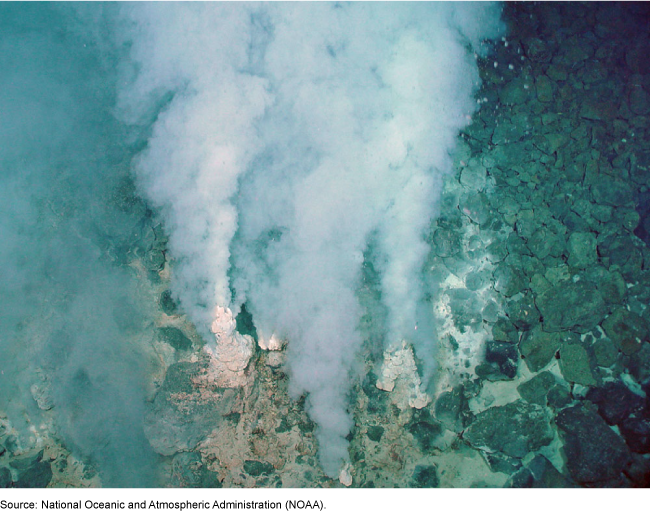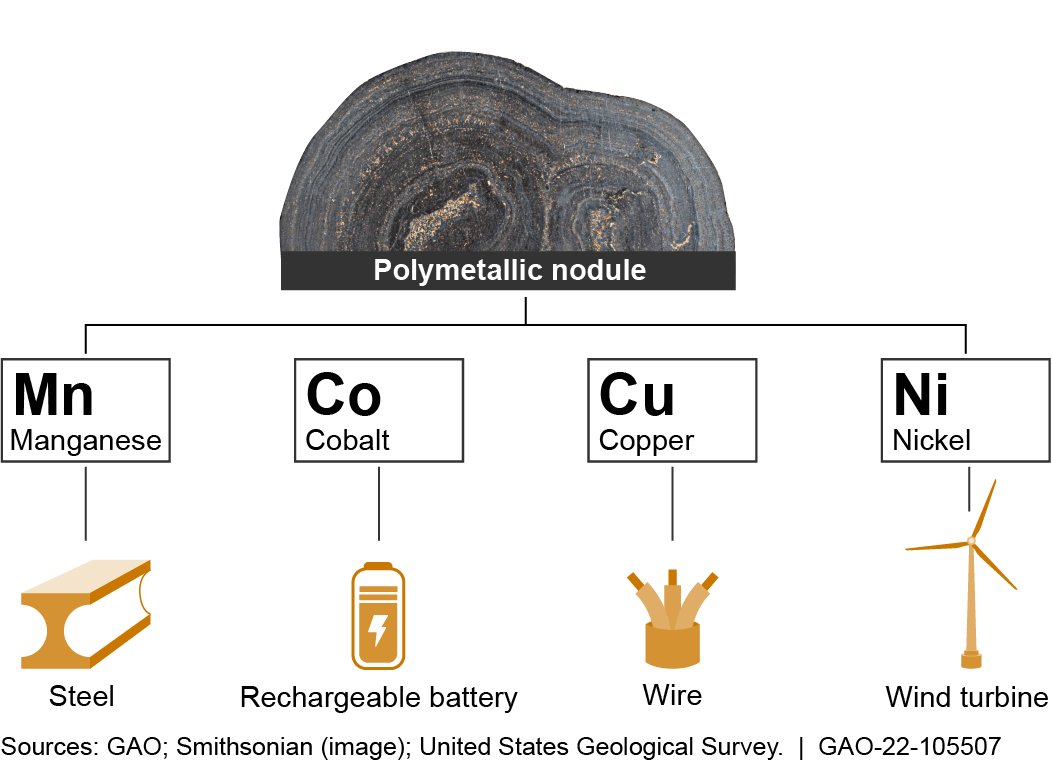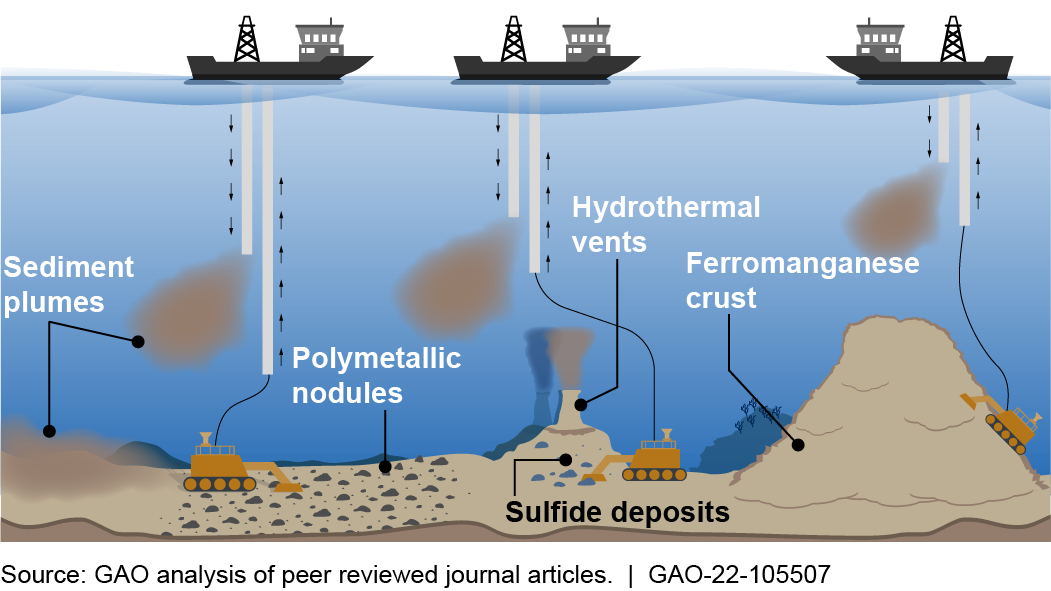Science & Tech Spotlight: Deep-Sea Mining

Why This Matters
The ocean floor contains vast quantities of critical minerals vital for many applications, such as aircraft components and rechargeable batteries. Increased demand for such minerals has driven technology development for exploration and extraction from deep-sea mining. However, the long-term environmental effects from deep-sea mining are as yet unknown.
The Technology
What is it? Deep-sea mining is the process of exploring for and retrieving minerals from the deep seabed. Three types of deposits hold most of these minerals: polymetallic nodules, also called manganese nodules, which are lying on the seabed; sulfide deposits around hydrothermal vents; and ferromanganese crusts, which are rich in cobalt and manganese and line the sides of ridges and seamounts.
These sources hold a wide variety of critical minerals, including cobalt, manganese, titanium, and rare earth elements, as well as gold, copper, and nickel (see fig. 1). Many of these minerals are in international waters. For example, the Clarion-Clipperton Zone, which spans 1.7 million square miles between Hawaii and Mexico, holds trillions of polymetallic nodules. Mining for sand, gravel, and aggregates is underway nearer to shore, but these areas hold only limited critical minerals.

Figure 1. Cross-section of a polymetallic nodule, approximately 1 to 4 inches in diameter, showing the critical minerals that can be found within the nodule, and their applications.
These minerals play an important role in the U.S. economy, contributing to industries such as transportation, defense, aerospace, electronics, energy, construction, and health care. The International Energy Agency expects demand for cobalt, copper, nickel, and rare earth elements to at least double (or possibly more than triple) within the next 20 years. Researchers continue to develop technologies for locating and extracting mineral samples and for establishing deep-sea mining operations.
How does it work? Private companies have developed several technologies and designs for both exploration and systems to deliver extracted material to ships or surface-based mining platforms. For example, underwater remotely-operated vehicles (ROVs) can be used to locate prime extraction sites and collect samples from the seabed.
Companies are also developing technologies to collect material from the seabed. Designs to gather polymetallic nodules include a vacuum to systematically dredge large swaths of the seafloor, along with hydraulic pumps and hose systems that lift the extracted materials to surface vessels or platforms. Extraction of sulfide deposits around hydrothermal vents or the slopes of undersea ridges could involve drilling and cutting into the crust, breaking up the materials, and transporting the pieces to the surface in a similar system (see fig. 2).

Figure 2. Examples of extraction systems for deep-sea mining.
What are some concerns? These deep-sea mining methods may have environmental effects. Specifically, extraction processes create sediment clouds at the seabed or in the water above. These clouds, which could contain toxic heavy metals and spread over long distances, would eventually settle back to the seabed. Furthermore, disturbing the seabed may destroy habitat, with unknown effects on sea life. Researchers are studying these and other effects. For example, in August 2020, a collaborative program involving more than 100 U.S. and international researchers was established to study the potential environmental effects of Pacific Ocean polymetallic nodule mining.
How mature is it? Advances in several technologies have made it possible to explore and sample wide areas of the ocean floor. These advances have generated improvements in undersea imaging, software for predicting the locations of mineral fields, and guidance for ROVs.
Multiple companies are designing and testing technologies for retrieving material, including hydraulic pumping and conveyance systems. Some of this testing has occurred to depths of approximately 21,000 feet.
To date, there are no deep-sea commercial mining operations though several companies are progressing in that direction. For example, a Canadian company reported that it is retrofitting a former ultra-deep-sea drilling vessel as the first sub-sea mining vessel. It anticipates beginning a pilot mining project in mid-2022 to retrieve polymetallic nodules.
Opportunities
- Technology applications. Minerals found in the seabed, such as cobalt, manganese, nickel, and rare earth elements, are important components of smartphones, steel, and green technologies including solar cells, electric vehicles, and wind turbines. Some of these minerals are rare on land; deep-sea mining could provide a valuable source.
- Access to critical minerals. According to a 2019 Department of Commence report, the U.S. needs to mitigate the risk of being heavily dependent on critical mineral sources under foreign government control. Currently, such sources include China, Russia, and the Democratic Republic of the Congo. Mining deep-sea minerals could provide an alternative source for critical minerals.
- Less reliance on land-based mining. Land-based mining can adversely affect the terrestrial environment. For example, acid rock drainage (created by the exposure of crushed rocks to air and water) can release harmful contaminants, such as arsenic, mercury, and lead. Advances in deep-sea mining may decrease those effects by reducing the demand for land-based mining.
Challenges
- Environmental effects. Researchers currently lack data on the extent to which sediment plumes from deep-sea mining could affect ecosystems or spread to other countries on ocean currents.
- International relations. U.S.-based deep-sea mining companies could face uncertainties when operating beyond the U.S. exclusive economic zone (which generally extends up to 200 nautical miles from shore), according to industry experts. The U.S. has agreements with some countries but is not a party to the 1982 United Nations (UN) Convention on the Law of the Sea and its related International Seabed Authority, which regulates and controls mining of the international seabed area between member countries.
Policy Context and Questions
With increased demand for critical minerals and the unknown long-term environmental effects of deep-sea mining, key questions for policymakers include:
- What analyses of incentives and barriers might help clarify the viability of private sector deep-sea mining as an alternative to land-based critical mineral resources, especially those under foreign control?
- What are the trade-offs for the U.S. in ratifying the UN Convention on the Law of the Sea?
- What research is needed to understand the environmental effects of deep-sea mining and ways to mitigate those effects, and who should conduct this research?
For more information, contact Karen Howard at (202) 512-6888 or [email protected].








